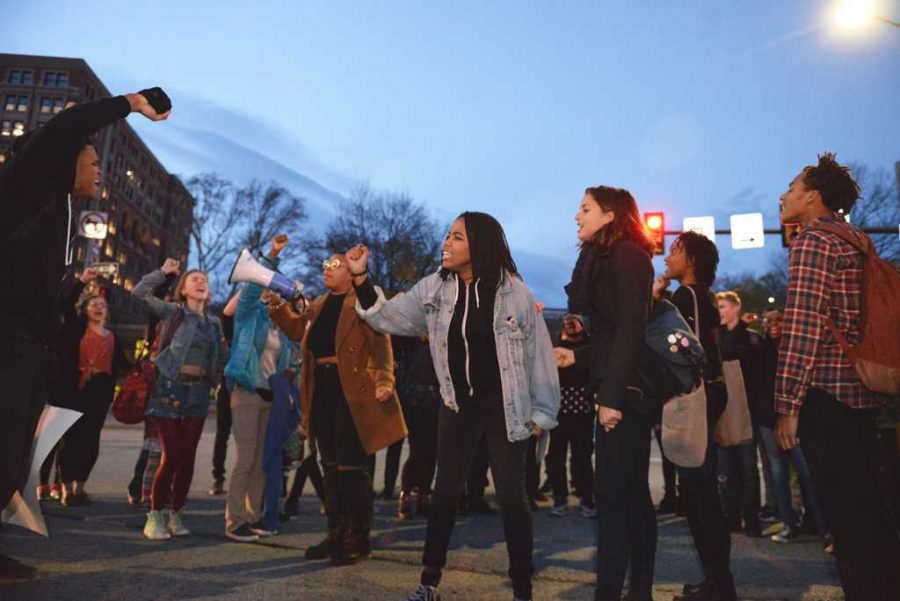Emily Cimini was on her way to work on a group project in Schenley Plaza when a throng standing on the corner of Forbes and Bigelow caught her attention.
Realizing that this was a protest that dealt with race issues, Cimini stopped and joined.
“I love to be present … just to hear what their views are,” Cimini, a graduate student studying social work said.
From 4:30 to 5:30 p.m. on Wednesday, Cimini and about 100 other college and high school students rallied at Schenley Plaza to stand in solidarity with students at the University of Missouri, who recently saw their president, Timothy Wolfe, resign amidst racial unrest on campus. The protest was also part of the Black Liberation Collective’s student blackout day to end racial injustice.
“There needs to be more student and public awareness,” Cimini said. “That’s where the divide lies, just being uneducated and not understanding what [this] movement is actually for.”
Racist, anti-Semitic and anti-gay actions escalated racial tensions at the University of Missouri this month. Members of the football team refused to practice or play, a student went on a hunger strike and students and faculty protested throughout the campus, all calling for Wolfe’s resignation over his lax response to racial injustice on campus.
The protest was originally set to begin at 4 p.m., but organizers delayed out of respect for a nearby vigil outside Posvar Hall, held for the victims of the Paris attacks. During that time, protesters gathered in a circle with their right hands in the air, forming a fist.
When the protest began, the crowd formed a semicircle around the event’s five organizers, who represented local colleges and high schools such as Pitt, CAPA and Winchester Thurston.
With a bullhorn in hand, the organizers took turns starting chants, with the crowd echoing their calls. The chants included, “No justice, no peace, no racist police,” “Pittsburgh, can you hear us now, we will bring the system down” and “Unapologetically black.”
The organizers, who were high school students, refused to give their individual names, but collectively called themselves Turn Up for Freedom, said they were standing in solidarity with the Black Liberation Collective and with students nationwide to spread an educational message of equality.
Between chants, the organizers talked about issues such as police brutality, how schools use students’ tuition money and the frequency of terrorist attacks outside of Paris. However, most of the conversation was directed toward the importance of education.
“It seems like a basic idea, a basic thought. But it is not happening,” one organizer said. “That is why we are here, to demand that black students be able to feel safe. To be able to learn. To be able to grow. If it’s not happening in our schools, then what next?”
The protest culminated with ralliers spreading to all four corners of the Forbes-Bigelow intersection and chanting. The students moved to the center of the intersection and police on bicycles blocked traffic on Forbes Avenue. The chanting crowd in the center dispersed less than five minutes after it moved into the intersection, and traffic resumed normally.
According to Derek Jones, a sophomore history and anthropology major, Pitt’s situation resembles Missouri’s because they both have small percentages of minority students and faculty. Jones said he has only had one minority professor in his academic career.
“There aren’t the professors there to represent these people,” Jones said. “They don’t see their own faces in their classrooms and they feel isolated because of that.”
According to Pitt’s Office of Institutional Research 2015 Factbook, 8.2 percent of the fall 2014 student body was black or mixed race and 6.9 percent of the fall 2014 faculty were black or mixed race.
Despite a more racially diverse population at Pitt, Jones said Pitt can learn from the protests at Mizzou.
“The best thing we can learn from Missouri is that we have the power,” Jones said. “We pay tuition here. We are the students. No one else can really tell us what can be achieved.”



